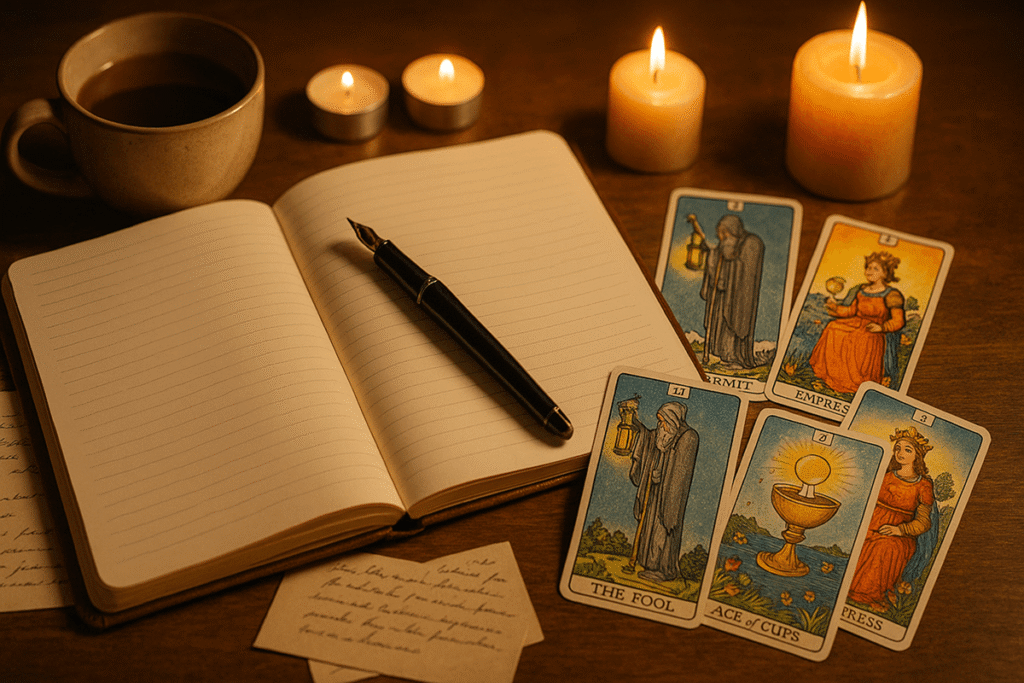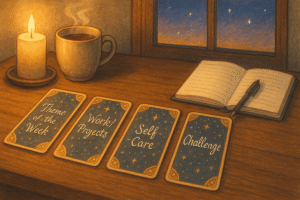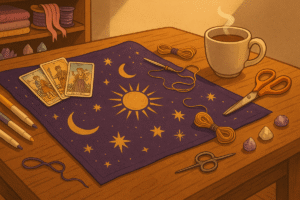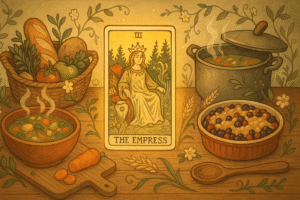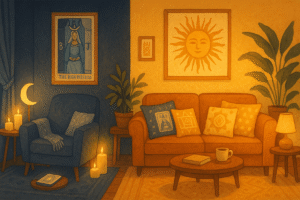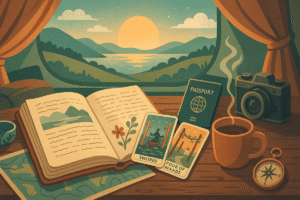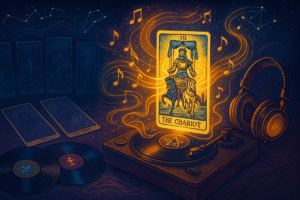Table of Contents
Every writer knows that feeling. You’re sitting there, cursor blinking mockingly at you from a blank page, and inspiration feels like it’s hiding in some distant corner of the universe. I’ve been there more times than I care to admit. Perhaps you’ve tried the usual remedies: writing exercises from books, random word generators, or staring out the window hoping lightning will strike. But have you ever considered reaching for a deck of tarot cards?
Now, before you raise an eyebrow, hear me out. Using tarot cards as writing prompts isn’t about predicting your story’s future or consulting mystical forces. It’s about tapping into a rich visual and symbolic language that has captivated human imagination for centuries. Each card in a tarot deck is essentially a tiny work of art packed with archetypal imagery, emotional depth, and narrative potential.
The beauty of this approach lies in its simplicity and unpredictability. When you draw a card, you’re not just getting a random image – you’re accessing symbols that have evolved over hundreds of years to represent fundamental human experiences, emotions, and situations. It’s like having 78 different story starters sitting right there on your desk.
Why Tarot Cards Work as Creative Catalysts
There’s something almost magical about the way our minds respond to symbolic imagery. When you look at The Fool card, for instance, you might see a young person stepping off a cliff with a bindle over their shoulder, a white dog at their heels, and mountains in the distance. Your brain immediately starts asking questions. Who is this person? Why are they taking such a leap? What’s in that bag? Where are they going?
This questioning process is exactly what good storytelling requires. The cards don’t provide answers; they provoke inquiries. They invite you to fill in the blanks with your own imagination and experiences. I think this is what makes them so effective as writing tools – they give you just enough structure to get started without boxing you into any particular direction.
The imagery in tarot cards tends to be archetypal, meaning it resonates with universal human experiences. Love, loss, conflict, triumph, mystery, transformation – these themes appear again and again across different decks and artistic interpretations. When you’re struggling with character development or plot direction, these archetypes can provide a foundation to build upon.
What’s particularly interesting is how the cards can surprise you. You might draw The Tower, expecting to write something dramatic about destruction, only to find yourself crafting a quiet story about someone cleaning out their childhood bedroom. The cards don’t dictate your interpretation; they simply offer a starting point for your creativity to explore.
Getting Started with Tarot Writing Prompts
You don’t need to be familiar with traditional tarot meanings to use cards as writing prompts. In fact, approaching them with fresh eyes can be incredibly liberating. The goal isn’t to write about tarot or incorporate mystical elements into your stories (unless that’s what appeals to you). The cards are simply visual and thematic inspiration.
Start by choosing a deck that speaks to you aesthetically. Some writers prefer classic imagery like the Rider-Waite deck, while others gravitate toward more modern or artistic interpretations. The important thing is that the images engage your imagination. I’ve found that decks with detailed artwork tend to provide more specific prompts, while simpler designs leave more room for interpretation.
Your first exercise could be as simple as drawing a single card and writing for ten minutes about whatever comes to mind. Don’t worry about creating a polished story; just let your thoughts flow. You might describe the scene in the card, imagine what happened before or after the moment depicted, or explore the emotions the image evokes.
Perhaps you’ll draw the Three of Cups and find yourself writing about a reunion between old friends. Or maybe The Hermit will inspire a piece about someone seeking solitude after a major life change. The key is to follow your instincts rather than worrying about “correct” interpretations.
As you become more comfortable with the process, you can experiment with drawing multiple cards. Try pulling three cards and using them to represent the beginning, middle, and end of a story. Or draw cards to represent different characters in a narrative you’re developing.
Character Development Through Card Imagery
One area where tarot cards particularly shine is character creation. Each court card (King, Queen, Knight, and Page of each suit) can represent different personality types, while the major arcana cards often embody various life stages or archetypal roles.
When I’m developing a new character, I sometimes draw a card and ask myself how this person might embody the energy or essence of what I’m seeing. The Queen of Swords, with her direct gaze and raised blade, might inspire a character who values truth above diplomacy. The Page of Pentacles could represent someone young and eager, just starting their professional journey.
But here’s where it gets interesting – you don’t have to stick to obvious interpretations. Maybe that Queen of Swords is actually someone who appears stern but is secretly protecting something vulnerable. Perhaps the Page of Pentacles represents someone who’s older but approaching a new field with beginner’s enthusiasm.
The visual elements in the cards can also inform character details. Does your character have the same determined expression as the figure in the Seven of Pentacles? Do they carry themselves with the regal bearing shown in The Emperor? These small details can help bring your characters to life in unexpected ways.
I’ve noticed that using cards for character development often leads to more complex, nuanced personalities than I might create otherwise. There’s something about responding to an external prompt that pushes me beyond my usual patterns and assumptions.
Plot Development and Story Structure
Beyond character creation, tarot cards can help generate plot points and story structure. The natural progression within each suit – from Ace through Ten – can represent a journey or development arc. The major arcana cards, when drawn in sequence, often tell a story of personal growth and transformation.
You might draw several cards and arrange them as a timeline for your story. What if the Two of Swords represents your protagonist’s initial dilemma, the Five of Swords shows a conflict that arises, and the Ten of Cups represents the resolution they’re working toward? This approach can help you map out a narrative structure without getting bogged down in detailed plotting.
Sometimes I use cards to break through specific story problems. If I’m stuck on how a scene should unfold, drawing a card can provide an unexpected element or direction. The appearance of The Wheel of Fortune might suggest that chance or fate plays a role in this moment. The Four of Wands could indicate that celebration or achievement is part of the scene.
The beauty of this method is its flexibility. You’re not bound by traditional card meanings or any predetermined system. The cards are simply visual prompts that can spark new ideas or offer fresh perspectives on existing stories.
Overcoming Writer’s Block with Random Inspiration
Writer’s block often stems from overthinking or putting too much pressure on ourselves to create something perfect. Tarot cards can interrupt this cycle by introducing an element of randomness and play into the writing process.
When you’re stuck, try drawing a card and giving yourself permission to write something completely unrelated to your current project. The change of focus can be refreshing, and you might discover ideas that unexpectedly connect to your main work.
I remember once being completely stuck on a dialogue scene between two characters. Nothing felt natural or authentic. On impulse, I drew The Moon card and started writing about the strange dreams one of the characters had been having. That exercise led me to understand something deeper about the character’s psychological state, which in turn informed how they would speak in the dialogue I was struggling with.
The cards can also help when you’re between projects and unsure what to write next. Draw several cards and see what themes or images capture your attention. You might find yourself drawn to the domestic scene in the Ten of Pentacles, inspiring a family saga, or intrigued by the mysterious figure in The High Priestess, leading to something with elements of mystery or hidden knowledge.
Building a Regular Practice
Like any creative tool, tarot cards for writing work best when used consistently rather than just when inspiration strikes. Consider incorporating card draws into your regular writing routine. You might pull a daily card and write a short piece inspired by it, or use cards at the beginning of each writing session to set an intention or focus.
Some writers create themed challenges for themselves, like writing a story inspired by each card in the major arcana over the course of several months. Others use cards to explore different genres – letting a card’s mood and imagery guide them toward horror, romance, fantasy, or literary fiction.
The important thing is to approach this practice with curiosity rather than pressure. Not every card draw will result in a masterpiece, and that’s perfectly fine. The goal is to keep your creative muscles active and open to new possibilities.
What I find particularly valuable about using tarot cards as writing prompts is how they’ve expanded my storytelling range. I’ve written pieces I never would have conceived without that external spark of inspiration. The cards have pushed me to explore themes, characters, and situations outside my comfort zone, ultimately making me a more versatile writer.
Whether you’re a seasoned author looking to break through creative barriers or someone just beginning their writing journey, tarot cards offer a unique and accessible way to generate fresh ideas. They remind us that inspiration can come from anywhere – even a deck of centuries-old images sitting quietly on our desk, waiting to unlock the next great story.
Frequently Asked Questions
Do I need to know traditional tarot meanings to use cards for writing?
Not at all. While understanding traditional meanings can add depth to your practice, many writers successfully use tarot cards purely as visual prompts without any knowledge of their conventional interpretations. The images themselves are rich enough to spark creativity. You can simply respond to what you see in the artwork, the colors, the emotions conveyed, and the symbols that catch your attention. Your personal interpretation is just as valid as any traditional meaning when you’re using cards for creative writing.
Which tarot deck should I choose for writing purposes?
Choose a deck whose artwork resonates with you visually. While the classic Rider-Waite deck is popular because of its detailed imagery, any deck that captures your imagination will work. Some writers prefer decks with rich, detailed scenes that provide more visual storytelling elements, while others like minimalist designs that leave more room for interpretation. Consider browsing different decks online or at a bookstore and selecting one whose aesthetic style appeals to you. The connection you feel to the images matters more than following any particular tradition.
Can I use tarot cards for genres other than fantasy or mystical fiction?
Absolutely. Tarot cards work beautifully across all genres. The archetypal imagery translates well whether you’re writing contemporary romance, science fiction, mystery, or literary fiction. A writer working on a corporate thriller might draw the Five of Swords and explore themes of conflict and ambition in a business setting. Someone crafting a family drama could use the Ten of Cups to inspire scenes about gathering and celebration. The cards provide universal themes and emotions that appear in every type of story.
How often should I draw cards for writing inspiration?
There’s no right answer here. Some writers pull a card at the start of each writing session as a warm up exercise. Others only reach for their deck when they’re stuck on a particular story problem. You might establish a daily practice of drawing one card and writing for ten minutes, or you might keep the deck nearby for occasional inspiration. Experiment with different frequencies and see what rhythm supports your creative process best. The goal is to make it helpful rather than obligatory.

